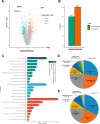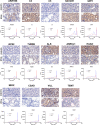Proteomics and transcriptomics profiling reveals distinct aspects of kidney stone related genes in calculi rats
- PMID: 36932340
- PMCID: PMC10024419
- DOI: 10.1186/s12864-023-09222-7
Proteomics and transcriptomics profiling reveals distinct aspects of kidney stone related genes in calculi rats
Abstract
Backgrounds: Kidney stone also known as urolithiasis or nephrolithiasis, is one of the oldest diseases known to medicine, however, the gene expression changes and related kidney injury remains unclear.
Methods: A calculi rat model was developed via ethylene glycol- and ammonium chloride-induction. Integrated proteomic and transcriptomic analysis was performed to characterize the distinct gene expression profiles in the kidney of calculi rat. Differential expressed genes (DEGs) were sub-clustered into distinct groups according to the consistency of transcriptome and proteome. Gene Ontology and KEGG pathway enrichment was performed to analyze the functions of each sub-group of DEGs. Immunohistochemistry was performed to validated the expression of identified proteins.
Results: Five thousand eight hundred ninety-seven genes were quantified at both transcriptome and proteome levels, and six distinct gene clusters were identified, of which 14 genes were consistently dysregulated. Functional enrichment analysis showed that the calculi rat kidney was increased expression of injured & apoptotic markers and immune-molecules, and decreased expression of solute carriers & transporters and many metabolic related factors.
Conclusions: The present proteotranscriptomic study provided a data resource and new insights for better understanding of the pathogenesis of nephrolithiasis, will hopefully facilitate the future development of new strategies for the recurrence prevention and treatment in patients with kidney stone disease.
Keywords: Calcium oxalate; Kidney stone; Proteomics; Transcriptomics; Urolithiasis.
© 2023. The Author(s).
Conflict of interest statement
The authors declare seriously that external funding sources and interest conflicts did not exist in the study.
Figures








References
-
- Shadman A, Bastani B. Kidney Calculi: Pathophysiology and as a Systemic Disorder. Iran J Kidney Dis. 2017;11(3):180–191. - PubMed
MeSH terms
Substances
Grants and funding
- JCYJ20210324131414039/Shenzhen Fundamental Research Program
- LHKJCXJCYJ202002, 2020003 and 2020013/Scientific Research Projects of Medical and Health Institutions of Longhua Shenzhen
- LHKJCXJCYJ202002, 2020003 and 2020013/Scientific Research Projects of Medical and Health Institutions of Longhua Shenzhen
LinkOut - more resources
Full Text Sources

